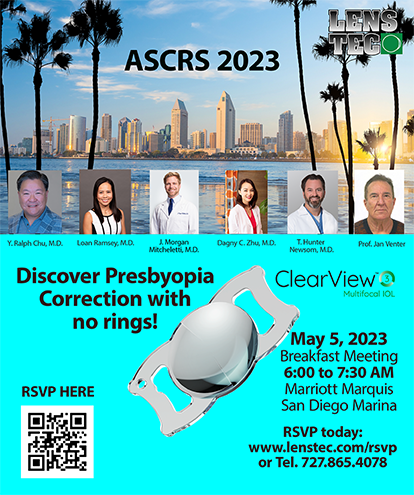It seems there has been interest in the sustained release of drugs for the eye quite literally for millennia. If we believe the story, Cleopatra used belladonna plasters on her eyes in the first century BCE. Much later, surgeons in the 19th century sought ways of achieving sustained delivery of cocaine for ocular anesthesia.
The interest continues today, with increasing levels of research and investment into novel drug delivery technologies. Despite the long history, sustained ocular delivery is still an embryonic market with huge opportunities for advances. Multiple companies are engaged in development efforts for sustained delivery of drugs to both the anterior and posterior segments. I have had the good fortune to be involved in the launch of several technologies for sustained delivery of ophthalmic drugs over the past 2 decades, and, in this article, I hope to provide some historical perspective and to preview what may become a reality in the coming years.
LOOKING BACK
The first company to launch a drug delivery device for the eye was the Alza Corporation in the 1970s. Ocusert was an implant placed in the conjunctival sac for delivery of pilocarpine over a period of approximately 1 week. Ocusert was ultimately unsuccessful because it caused patient discomfort; however, it was the first effort in the modern era to develop a long-lasting drug delivery product for the eye.
It wasn’t until 20 years later, in 1995, that Chiron Vision launched Vitrasert, the world’s first intraocular drug delivery implant. Vitrasert (no longer available) delivered ganciclovir to the back of the eye to treat the orphan disease cytomegalovirus retinitis, an opportunistic infection associated with HIV.
This was the first time surgeons could put an implant into the posterior segment of the eye that could deliver a drug for 4 to 6 months, a major breakthrough for patients. The product was launched with a price of $4,500—a shock at the time—but the price was accepted given the fact that the device could deliver drug for such a length of time for this unmet medical need.
It was almost another 10 years before the next intraocular implant appeared. In 2005, Bausch + Lomb launched Retisert (fluocinolone acetonide 0.59 mg). The company had acquired Chiron Vision’s technology, and Retisert used the same technology as Vitrasert but was smaller. It was labeled by the FDA for the treatment of the orphan disease noninfectious posterior uveitis, and it could deliver treatment for more than 32 months.
With the appearance of this second product, companies began to recognize the potential of developing implants as vehicles for drug delivery to the back of the eye. In 2009, Allergan launched Ozurdex (dexamethasone implant 0.7 mg), which was different from the preceding implants in that it did not require a trip to the OR. This was another breakthrough, the first time a drug delivery implant could be injected in the clinic. Ozurdex is now indicated for the treatment of macular edema secondary to retinal vein occlusion, noninfectious posterior uveitis, and diabetic macular edema (DME), and it releases dexamethasone for roughly 6 months.
In 2011, Alimera Sciences launched Iluvien (fluocinolone acetonide implant 0.19 mg), containing the same steroid as Retisert but even smaller and able to be injected rather than implanted. Iluvien is indicated for treatment of DME.
The posterior segment pharmacologic landscape changed dramatically in 2006 with the introduction of the anti-VEGF drug ranibizumab (Lucentis, Genentech). This large-molecule biologic drug is indicated for treatment of neovascular age-related macular degeneration, DME, and macular edema following retinal vein occlusion. A second novel large-molecule anti-VEGF biologic, aflibercept (Eylea, Regeneron), was introduced a few years later.
An EMERGING NEED
The introduction of anti-VEGF drugs was a significant advance in the management of patients with wet age-related macular degeneration. The downside is that they require frequent intravitreal injections. There is an emerging need today, therefore, for sustained-release delivery of these large-molecule antibody products.
Genentech is developing the Port Delivery System, a refillable implant for sustained delivery of ranibizumab. This device has been evaluated in phase 2 clinical trials,1 and phase 3 trials are underway. Some companies are now making progress in extending formulations up to 12 weeks. New therapeutics in development may have a 12-week label; but, the ultimate goal would be to provide sustained drug delivery for up to 6 months. Another company working to develop sustained-release delivery systems for biologic products is Re-Vana Therapeutics. Its EyeLief photo-crosslinked technology is aimed at achieving delivery for 4 to 6 months.
ANTERIOR SEGMENT DEVELOPMENTS
Although glaucoma is a disease that affects the optic nerve, we continue to view glaucoma as an anterior segment disease. Pharmacologic treatment for glaucoma is carried out exclusively through the anterior segment route. A multitude of companies are investigating sustained-release technologies for glaucoma management. This is a highly valuable unmet medical need because of the burden placed on patients by the regimen of daily topical drop administration.
In this arena, the most notable activity at present in the development of sustained-release modalities is Allergan’s Bimatoprost SR implant. This sustained-release bioerodible implant containing bimatoprost is injected into the anterior segment as an in-office procedure or at an ambulatory surgery center. In phase 2 trials, it showed favorable safety and efficacy through 6 months.2 Phase 3 trials are underway. (For more information, see the accompanying sidebar, Bimatoprost SR.)
A similar unmet need lies in the treatment of dry eye disease (DED), which also requires frequent instillation of eye drops. DED is a multibillion dollar market, and several companies are exploring sustained-release technologies in this space. A technology commercialization group called C20/20 from McMaster University in Hamilton, Ontario, Canada, is developing a micelle technology for DED based on mucoadhesion. If this venture is successful, patients could administer eye drops perhaps once or twice a week, rather than several times per day.
Micelles are nano-sized structures built from polymeric molecules. Micelle is not a true sustained-release technology, but it provides a sustained effect in the eye. A number of applications for extended drug delivery in the anterior segment use micelle technology.
RECENT LAUNCHES
Two of the most recent introductions in the area of sustained-release technologies—one for the anterior segment and one for the posterior segment—have come from EyePoint Pharmaceuticals. In 2018, the FDA approved both Dexycu (dexamethasone intraocular suspension 9%) and Yutiq (fluocinolone acetonide intravitreal implant 0.18 mg).
Yutiq, indicated for treatment of noninfectious posterior uveitis, is based on the Durasert technology developed by pSivida, similar technology to that used in Iluvien.
Dexycu, indicated for postcataract inflammation, is one of the first true anterior segment sustained-release products to come onto the market. It uses the company’s Verisome technology, which supplies sustained release of small molecules in suspension.
Also in 2018, Ocular Therapeutix announced the FDA approval of Dextenza (dexamethasone ophthalmic insert 0.4 mg) to treat ocular pain following ophthalmic surgery. The intracanalicular insert delivers drug to the ocular surface for up to 30 days. (For more information on Dextenza, see the accompanying sidebar, Drop the Drops.)
MORE TO COME
To review, in the almost 25 years since 1995, we have seen the launches of only seven sustained-release ophthalmic products: Vitrasert, Retisert, Ozurdex, Iluvien, Dexycu, Yutiq, and Dextenza. There is a notable trend among these products: All of them dispense familiar or generic drugs. These are (or were) novel devices, but they did not carry novel drugs. It’s quite a different task to take a novel drug and make it work with a new delivery technology. This is something we most likely will see more of in coming years.
Today, sustained drug delivery is still an embryonic area with incredible opportunities going forward. I believe the single biggest opportunity will be for sustained-release biologics, but there is certainly also a need for glaucoma and DED products.
Sustained-release delivery of biologic drugs for periods of 4 to 6 months will not be easy to achieve because proteins can become denatured fairly quickly. Additionally, the devices must have the drug-loading capacity to deliver the right dose of these large-molecule drugs at therapeutic levels for the desired period. Some of the new technologies under development are set to overcome these challenges.
Where else can ophthalmic drug delivery go? Obviously the emerging areas of gene and stem cell therapies will see continued development. Will sustained-release technologies have a role in these products going forward? Any product that can prolong duration of effect—whether for a small molecule, a large molecule, gene therapy, or cell therapy—is a potential advance.
The great opportunity and challenge will lie in combining novel therapeutics with sustained-release technologies at early stages of product development: that is, in phase 1 or phase 2 clinical trials. I believe we will see more of these approaches from major companies with novel therapeutics. Rather than wait for product approval and then consider drug delivery vehicles, they will tackle both, together, from the outset.
This will present heightened challenges to get products approved. Not only will companies have to get the drug right, but they will also have to get the delivery technology right, plus, they will have to successfully match the former with the latter. It will be fascinating to see efforts play out, and I hope the developments of the next 25 years match and exceed the developments we have seen in the preceding period.





